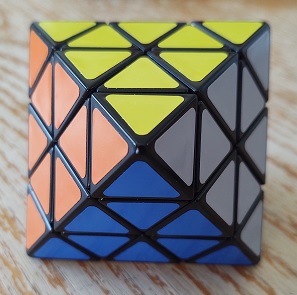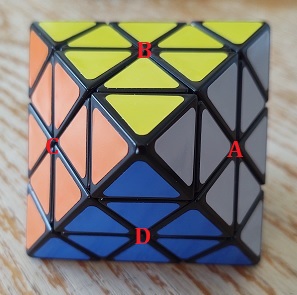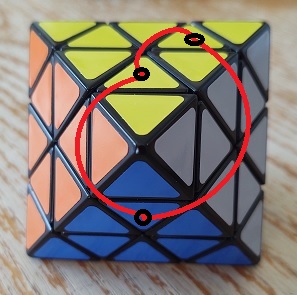

I enjoyed this one. It's like the octahdron version of a Rubik's cube, but there are no center face pieces.
For the purposes of solving this puzzle, we'll only need to label half the faces as follows.

There are 3 classes of pieces in this puzzle: corners, edges and faces. The corners can be positioned and oriented incorrectly. The edges can be positioned incorrectly, but once positioned correctly, the orientation is always correct. And, of course, faces can be positioned incorrectly, but orientation does not matter.
I like to solve corners first. Solve 3 of them in a single face. The opposite face (let's say it's the D face)
will then have the remaining three corners, and you can use X=A,Ci,Ai,C until they're all oriented properly, then
just use D until they're positioned properly.
Next, solve the edges. All that's needed is to get them into position. I like to use a process similar to the
key-hole method on the 3x3x3 Rubik's Cube to get all edges solved on opposite faces. Once that's done, rotate the
middle slice between those opposite faces until the remaining edges are as solved as possible. Then use a tri-cycle
similar to 4[A,Bi,Ai,B] to permute edges without distrubing the corners.
All that remains is to position the face pieces. For this, there is a 5-cycle that can be useful by itself.
It is Y=X,!D,X,!Di. (Note that the ! notation changes your perspective mid-sequence,
which affects the meaning of subsequent rotations. See the index page for info on notation.)
A piece of tape stuck to a face can help you discover the 5-cycle by looking at the orbit of the tape.
Anyhow, a tri-cycle can be built from this, and it is Y,B,Yi,Bi. Admittedly, your brain has
to go into a bit of a pretzil to figure out what Yi means, but once you figure it out, it's not hard.
The face pieces tri-cycled by this are illustrated as follows.

Combining this tri-cycle with setups will get the puzzle into a solved state. I say, "a solved state", of course, rather than "the solved state", because I'm sure that face pieces of the same color could change position from how the puzzle came to you in the mail. There is a group-theory term for this that I used to remember, but it has long since fled my decaying brain. Okay, I think it might be the distinction between isomorphism and homomorphism...? I can't remember. I think that all of the solved state possibilities form a factor group or something like that, of which you can "mod-out" by.